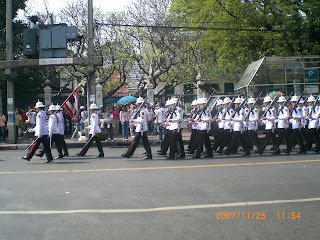
Monday, November 26, 2007
Sunday, November 25, 2007
Burma’s Bloggers Award Free of Press Award

Media coverage of the pro-democracy protests in Burma depended largely on the bravery of the country’s few bloggers, using the internet and mobile phones.
For this they have received praise from around the world.
One Burmese blogger Jotman has just received the Reporters without Borders special prize in the international competition ‘best of the blogs.’
At the annual Burma Media Conference taking place in Thailand, blogs have also been highlighted as the medium of resistance.
King Kong Janoi reports from the conference.
“They started shooting at the front of the Shwedagone Pagoda. We could see what was happening. It was amazing they were uploading image almost simultaneously. For example at 12 o’clock in Yangon they were shooting at the monks and we could see the pictures immediately. At that time we could not study or do anything. We would just sit in front of the computer and watch the blogs from inside Burma. We are were very excited but I was also crying.”
Ma Sander a Burmese student in Thailand, like thousands of people, was glued to the blogs during the uprising.
“The blogs were like live television shows. Oh now they are shooting at the Shwedagone Pagoda. They are still marching at Su Lae Pagoda! The Blog made us very excited and we felt the pain because we knew exactly what was happening in Yangon. We really thank the bloggers.”
Yangon is one of these bloggers. He manages the site yangontoday.
But he is an unlikely activist.
Before the September uprising, all he was concerned about was making some money.
“We try do start a business. At first we want to create a website that would get lots of hits and therefore advertising. But we didn’t have the money to buy a domain and to create the web-design, so we did a simple blog instead. It was free and easy. So we uploaded news that was being blocked by the censors.”
His blog quickly became a popular site.
He worked almost 24 hours a day taking pictures with his mobile phone and then uploading them to the blog.
“At that time many blogs like ours were at the front-line of the movement showing the world what was happening. But after that the government cut out the internet and crackdown even on our blog. They can investigate and find out where we live. So we can’t even login to our blog. We don’t do it anymore.”
Burma’s military rulers effectively isolated the country from outside observers by shutting down Internet service providers and cell phone towers.
But Maung Maung Myint, a founder of the Burma Media Association in exile says despite this, the bloggers made a significant difference.
“They are actually more become than bloggers but they become civilian resistant activists. It was the bloggers who was sent all the pictures and sounds to the outside world. Some of them are really good so even the big media brought it and used it on their television stations.”
Sone See Yar another blogger who runs the site soneseayar.blogspot says he will continue blogging.
“There are many exile media organizations covering Burma but they can not easily see inside Burma. We aim to be alternative media. Good thing for blog we can see where is happening for example what is happening in Yangon, the people in Mandalay can see it so they become more active and get in volved in the movement. They become more and more angry about the junta.”
This was very different from the 1988 uprising.
Khin Min Zaw a blogger on the Thai-Burma boarder says back then it took up to two weeks to get video images onto the web.
“But now because of IT improvement we can see what is happening in Burma within an hour. The international community can learn that the Burmese people want democracy and they don’t want to be rule by a dictator. They are Buddhists but they cracked down on monks with violence. So all the people around the world were shocked.”
While the street protests have stopped for now.
The Bloggers say they are still working to create political awareness among their readers.
“In my blog I will write commentary about what needs to happen next. How can we support dialogue between Aung Suu Kyi and Gen Than Shwe. I also want to make the young people aware in my blog.”
Although only about one percent of the Burmese population has access to the Internet, during the saffron revolution, the people on the ground knew what was going on and were ready to make use of the technology to report it to the world.



